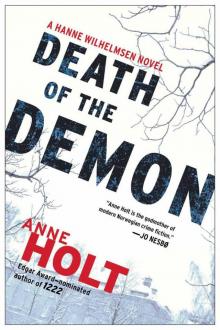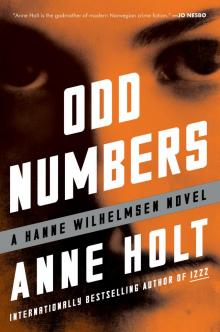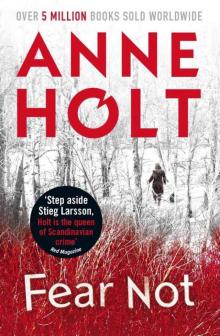What is Mine Read online
Page 19
Johanne dropped her felt-tip pen. It fell down into one of the folds in the duvet. A black stain grew instantly in the middle of all the white. The telephone rang.
Private Number, said the display.
Johanne didn’t know anyone who had a private number.
It must be Adam.
Adam and Warren were about the same age, she thought.
The phone continued to ring when she lay down and pulled the duvet over her head.
The next morning she had a dim memory of the telephone ringing a few times. But she wasn’t sure; her sleep had been heavy and dreamless, right through the night.
FORTY-ONE
Given the exceptional circumstances, the principal was nervous, even though staff numbers had been bolstered by two young trainee teachers. After all, she was the one who was responsible. In her opinion, a trip to the technology museum was reckless and unnecessary, but the others had convinced her. It was close enough for them to walk there and the ten children would be accompanied by four adults. The children had been looking forward to it for so long, and surely there were limits to the restrictions an insane abductor could impose on them. It was broad daylight and not yet noon.
The children were between three and five years old. They walked hand-in-hand, using the buddy system. The principal walked in front, with her arms out, as if she could somehow protect the children better that way. One of the students was at the back and the kindergarten’s only male employee walked beside them on the roadside, singing marching songs so that the children walked in time. Bertha, who was in fact the cook, was on the inside of the pavement.
“Left, right, hup-two-three, everyone keep up with me,” shouted the man. “One foot, two foot, on the ground, nobody look around. Keep your butt tight, shoulders back . . .”
“Shhhh,” said the principal.
“Butt,” screamed a child. “He said butt!”
Bertha stumbled over a crack in the asphalt and got left behind. One of the little girls let go of her friend’s hand to help.
“Butt,” repeated two boys. “Butt, butt!”
They passed the entrance to the Rema 1000 supermarket. A delivery van was trying to turn out onto Kjelsåsveien. The principal made angry gestures at the driver, who replied by giving her the finger. The van rolled slowly forward. Bertha screamed; little Eline stood petrified in front of the bumper. An unleashed dog lolloped over the road toward them. It wagged its tail and ran circles around three of the children, who eagerly tried to grab its green collar. The owner called from the path down by the Aker River. The dog pricked up its ears and bounded away again. A Volvo screeched on its brakes. The right fender clipped the dog, which howled and limped away on three legs. Eline was crying. The van driver rolled down his window and hurled abuse. The trainee teachers held their wards by the collar and tried to stop others from wandering into the road by standing with their legs apart on the edge of the pavement. Bertha picked up Eline. The van driver edged over the pavement and accelerated toward Frysjaveien. The dog whined in the distance. The owner was squatting beside it trying to calm it down. The driver of the green Volvo had stopped in the middle of the road, opened the door, and was obviously uncertain whether to get out or not. There were already four cars behind her, two of them honking angrily.
“Jacob,” said the principal. “Where’s Jacob?”
When Marius Larsen, the only male employee at Frysjakroken kindergarten, later tried to tell the police what had actually happened outside Rema 1000 on Kjelsåsveien, just before midday on Wednesday, May 31, he couldn’t remember the exact chain of events. He remembered all the elements of the incident. There was a dog and a Volvo. The van driver was foreign. The man who owned the dog was wearing a red sweater. Eline was howling and Bertha tripped on something. She was extremely overweight so it took a while for her to get up. The Volvo was green. They were singing marching songs. They were on their way to the technology museum. The dog was a pointer, gray and brown.
Marius Larsen had all the pieces, but couldn’t put them together. Eventually they asked him to write it all down. A patient officer gave him some yellow Post-its. One Post-it for each thing. He put them down in order, shuffled them around, thought about it, wrote new Post-its with stiff, bandaged fingers, tried again.
The end of the story was the only thing he was absolutely clear about.
“Jacob,” said the principal. “Where’s Jacob?”
Marius Larsen let go of two children. He spun around and saw that Jacob was already a hundred and fifty yards away, under the arm of some man who was opening the door of a car parked outside a garage further up the road, going east.
Marius ran.
He ran so fast that one of his shoes flew off.
When he was nearly at the car, no more than ten or twelve yards away, the engine started. The car swung out over pavement and into the road. Marius didn’t stop. Jacob wasn’t visible. He must be lying on the back seat. Marius threw himself at the car door. A broken beer bottle cut into his shoeless foot. The car door burst open with a thud, and Marius lost his balance. The driver hit the brakes. The door banged on its hinges. Jacob was crying. Marius didn’t let go of the door; he had a firm grip now, holding onto the window with his fingers. He wouldn’t let go. The car moved off again, jolting and jumping before suddenly accelerating, and Marius lost his grip. His hand was numb and the cuts on his foot were bleeding profusely. He lay on the asphalt in the middle of Kjelsåsveien.
Jacob was lying beside him, screaming.
It turned out the boy had broken his leg when he fell. But otherwise he was okay, all things considered.
Almost exactly five hours later, at ten to five on Wednesday afternoon, Adam Stubo, Sigmund Berli, and four detectives from Asker and Bærum Police stood at the entrance to a block of apartments in Rykkin. The stairwell smelled of wet concrete and cheap TV dinners. No curious neighbors stuck their heads out to have a look. No children approached them when they parked the three dark cars directly outside the building; three identical cars with badly disguised blue lights in front. All was quiet. It took them three minutes to pick the lock.
“I take it that all the formalities are in order,” said Adam Stubo, and entered the apartment.
“D’you know what, I don’t give a crap about that right now.”
The officer from Asker and Bærum followed him in. Adam turned around and blocked his way.
“It’s in just these situations that we need to be careful with things like that,” he said.
“Yeah, yeah. Everything’s fine. Now move.”
Adam didn’t know what he had expected. Nothing probably. Best that way. Nothing would surprise him, ever. He had his own little ritual for occasions like this. A short meditation with closed eyes before going in, to empty his brain, to let go of prejudices and assumptions that might or might not be well founded.
Now he wished he had prepared himself better.
Norway was unofficially in a state of emergency.
The news was broadcast only minutes after the actual event took place: yet another attempted abduction of a child. This time the police had a license plate number and a good description to go on. NRK-TV and TV2 cleared their program schedules. What was originally intended to be lots of short, special broadcasts quickly developed into one long one on both channels. At impressively short notice, both production teams managed to call in experts in most areas that might have any relevance to the case. Only a couple of them, a well-known child psychologist and a retired NCIS chief, were shuttled between the studios in Karl Johan 14 and Marienlyst. Otherwise both channels showed considerable creativity, at times too much. TV2 had a fifteen-minute interview with a funeral director. Thin, dressed in dark clothes and with as much emotion as he could muster, he explained the different reactions to grief of parents who lose their children under traumatic circumstances, padding it out with several thinly disguised anonymous examples. The viewers reacted with such disgust that the executive producer had to make a personal
apology before the end of the evening.
A witness in Kjelsåsveien had noticed that the abductor’s arm was in a cast.
Riled by the lack of interest shown by the police—they had noted his name and address and said they would contact him in a day or two—he rang TV2’s crimewatch desk. The description he gave was so precise that one of the crime reporters linked it to a recent arrest in Asker and Bærum. The man wasn’t quite all there, he seemed to remember, leafing through his notes. A vigilante group had broken his arm, but the case had died, as he refused to talk to journalists. And in any case, the police were convinced that he had nothing to do with the abductions.
The child killer who was haunting Norway like a nightmare and had already taken three lives, perhaps four, had been arrested earlier! And then been released, without being charged, only a few hours later. Even worse was the fact that the man had gotten away this time, too. A quick-thinking driver with a cell phone had alerted the police immediately, but the murderer had vanished all the same. A scandal of enormous proportions.
The Chief of Police in Oslo refused to make any comment. In a terse press release, the Minister of Justice referred to the Chief of Police. The Chief of Police just sat in his office and said nothing.
TV2 had a scoop that NRK could not hope to repeat. The witness came on television. Although he didn’t get his fifteen minutes of fame, the interview lasted for at least two. And what’s more, he could expect ten thousand kroner in his bank account. As soon as possible, assured the crime reporters, once the camera was turned off.
The worst thing was not the hard-core porn magazines that lay everywhere in piles.
There wasn’t much that Adam Stubo hadn’t seen already. The magazines were printed in four colors on cheap paper. Adam knew that they were largely produced in third-world countries, where children could be bought for a penny and a song and the police turned a blind eye for a fistful of dollars. Nor was it the fact that some of the children staring at him with blank eyes from the obscene pictures were no more than two. Adam Stubo had seen a six-month-old rape victim with his own eyes and had no illusions left. The fact that the occupant had a computer was more surprising.
“I misjudged the man,” he muttered, and pulled on some rubber gloves.
The worst thing was, in fact, the walls.
Everything that had been written about the abductions had been meticulously cut out and pinned up, from the first, moderate reports of Emilie’s disappearance to a two-page essay by Jan Kjærstad in Aftenposten’s latest morning edition.
“Everything,” said Hermansen. “He’s kept everything.”
“And more,” said the youngest officer; he nodded over at the photographs of the children.
They were the same photographs that were pinned up in Adam’s office. He went over to the wall and studied the copies. They were in plastic covers, but he could see immediately that they weren’t cut out of a newspaper.
“Downloaded from the Internet,” said the youngest officer, without being asked.
“Can’t be a complete idiot then,” said Hermansen without looking at Adam.
“I’ve already admitted it,” said Adam gruffly.
The living room was basically a kind of office. An operations center for a one-man army. Adam walked slowly around the room. There was a sort of system to the madness. Even the porn magazines were ordered in a perverse chronology. He noted that the magazines nearest the window contained pictures of children aged around thirteen to fourteen. The further into the room you went, the younger the victims were. He picked up a magazine at random from the sideboard by the kitchen door. He looked at the picture and felt his throat tightening before forcing himself to put it back without ripping it to shreds. One of the officers from Asker and Bærum was talking quietly on a cell phone. When he finished the conversation, he shook his head.
“They haven’t even found the car, let alone the man. And when you look at what we’ve got in here . . .”
He opened his arms.
“. . . I don’t particularly feel like going into the bedroom.”
The six policemen stood in silence and looked around. No one said a word. There was a commotion outside the apartment block. They heard cars stopping. Shouts. Heels running on asphalt. Still no one said a word. The policeman who didn’t want to check the bedroom pressed his thumb and index finger to his eyes. He made a face that made the colleague who was standing nearest him pat him uncomfortably on the shoulder. It stank of old semen. It stank of masturbation and dirty clothes. It oozed obscenity and shame and secrecy. Adam looked at Emilie on the wall. She was still just as serious; the coltsfoot falling onto her forehead. She looked like she knew everything.
“It’s not him,” said Adam.
“What?”
The others turned to look at him. The youngest was open-mouthed and his eyes were wet.
“I made a mistake about the man’s mental capacity,” Adam admitted, and tried to clear his throat. “He can obviously use a computer. He manages to contact the people who distribute this filth . . .”
He stopped and tried to find a more appropriate word, a harsher word that conveyed more about the printed material that lay in piles and stacks all over the place. “. . . this filth,” he repeated in vain. “He knows what’s going on. And we are nearly one hundred percent certain that he is the one who attempted the abduction on Kjelsåsveien today. His car. The broken arm. The description fits on all points. But it’s not . . . this is not the man who abducted and killed the other children.”
“And you’ve reached that conclusion all by yourself?”
The expression on Sigmund Berli’s face showed that he no longer regarded Adam Stubo as his partner. He was defecting to the other side. To Bærum Police, who knew that they had solved the case. If only they could find the man who lived in this apartment, amongst all the paper clippings and pornography and dirty clothes. They knew who he was and he would be caught.
“The man has already let himself get caught once. By two amateurs! He nearly got caught again today. Our man, the man we’re looking for, the man who killed Kim and Glenn Hugo and Sarah . . .”
Adam’s eyes did not leave Emilie’s photograph.
“. . . and who perhaps is holding Emilie captive somewhere . . . he wouldn’t let himself get caught. Not like that. He doesn’t try to abduct children on an outing with lots of adults to watch them, in broad daylight in his own car and with a giant cast on his arm. No way. You know that, you know you do. We’re just so bent on catching the bastard that we . . .”
“Well, perhaps you can explain to me what this is then?” interrupted Hermansen.
The policeman was not triumphant. His voice was flat, nearly resigned. He had pulled a folder out of a drawer. The folder contained a small stack of paper. Adam Stubo didn’t want to look. He suspected that the contents of the folder would turn the whole investigation. Over a hundred detectives who until now had worked on the theory that nothing was a given and that all options should be kept open—good policemen and women who had tried to look at all the angles and who knew that good detective work was the result of being patient and systematic—they would now all charge in one direction.
Emilie, he thought, this is about Emilie. She is somewhere. She is alive.
“Oh shit,” said the youngest policeman.
Sigmund Berli let out a long, low whistle.
More cars could be heard outside. Shouts and conversation. Adam went over to the window and carefully pulled the curtain to one side. The journalists had arrived, naturally. They were flocking around the main entrance. Two of them looked up and Adam let the gray curtain go. He turned back to face the room. The other four were standing around Hermansen, who was still holding a red folder in one hand. In the other he had a small pile of paper. When he lifted one of the sheets for Adam to see, the writing was easy to read, even from the window.
NOW YOU’VE GOT WHAT YOU DESERVED.
“It’s typed,” Adam pointed out.
&nbs
p; “Give it up,” said Sigmund. “Just give it up, will you, Adam. How could this guy know . . .”
“The messages on the children were written by hand. They were written by hand, people!”
“Should you or I talk to them out there?” asked Hermansen, putting the paper carefully back into the folder. “There’s not a lot we can say, but it’s probably most natural if I . . . as we’re in Asker and Bærum and all that.”
Adam Stubo shrugged his shoulders. He was silent as he pushed through the group of people that had gathered outside the low-rise building in Rykkin. He eventually reached his car and got in. He was just about to give up waiting for Sigmund Berli when his colleague got into the car, out of breath. They barely exchanged a word all the way back to Oslo.
FORTY-TWO
I don’t know how you manage it all,” exclaimed Bente, enthusiastically. “That was so good!”
Kristiane was asleep. She was normally restless when Johanne was expecting guests. In the early afternoon, she would already have long periods during which it was impossible to talk to her. She would roam from room to room, wouldn’t eat. Wouldn’t sleep. But tonight she had fallen into bed, exhausted, with Sulamit under one arm and Jack, dribbling with delight, under the other. The King of America had changed Kristiane, Johanne had to admit. This morning her daughter had slept until half past seven.
“Recipe,” said Kristin, swallowing. “I must get the recipe.”
“There isn’t one,” said Johanne. “I just made it up.”
The wine was good. It was half past nine on Wednesday night. Her head felt light. Her shoulders didn’t ache. The girls around the table were talking over each other. Only Tone had said she couldn’t come; she didn’t dare leave the children alone, given the situation. Especially after today.
“She’s always so damned worried,” said Bente, and spilled some wine on the tablecloth. “Those children do have a father. Ooops! Salt! Mineral water! Tone is so . . . so hysterical about everything. I mean, we can’t just hole ourselves up simply because there’s a monster on the loose!”

 A Grave for Two
A Grave for Two Dead Joker
Dead Joker Death of the Demon: A Hanne Wilhelmsen Novel
Death of the Demon: A Hanne Wilhelmsen Novel Punishment aka What Is Mine
Punishment aka What Is Mine Beyond the Truth
Beyond the Truth Death in Oslo
Death in Oslo The Blind Goddess
The Blind Goddess What Never Happens
What Never Happens 1222
1222 In Dust and Ashes
In Dust and Ashes Odd Numbers
Odd Numbers What is Mine
What is Mine What Dark Clouds Hide
What Dark Clouds Hide Blessed Are Those Who Thirst
Blessed Are Those Who Thirst Fear Not
Fear Not No Echo
No Echo Hanne Wilhelmsen - 01 - The Blind Goddess
Hanne Wilhelmsen - 01 - The Blind Goddess